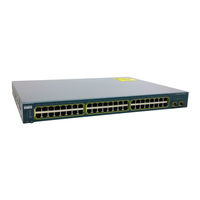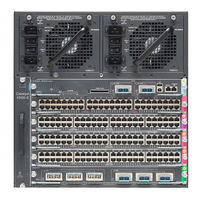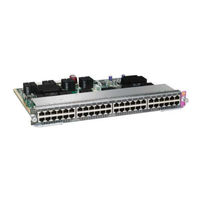Cisco 4510R - Catalyst Switch Campus LAN Manuals
Manuals and User Guides for Cisco 4510R - Catalyst Switch Campus LAN. We have 5 Cisco 4510R - Catalyst Switch Campus LAN manuals available for free PDF download: Configuration Manual, Overview, Datasheet, Description, How-To Manual
Cisco 4510R - Catalyst Switch Configuration Manual (612 pages)
Catalyst 4500 Series Switches
Table of Contents
-
-
-
-
-
-
-
-
LACP Modes90
-
-
-
-
-
-
Blocking State103
-
Listening State103
-
Learning State104
-
Forwarding State105
-
-
-
PVST+ Mode108
-
Rapid PVST108
-
MISTP Mode108
-
MISTP-PVST+ Mode109
-
-
Using PVST118
-
Using Rapid PVST124
-
Configuring MST142
-
-
CHAPTER 8 Configuring Spanning Tree Portfast, BPDU Guard, BPDU Filter, Uplinkfast, Backbonefast, and
157-
Configuring VTP177
-
-
-
VLAN Ranges209
-
-
-
-
Configuring VMPS256
-
VMPS Example264
-
-
Configuring Qos
277 -
-
-
Disabling Qos283
-
-
Configuring CGMP288
-
Enabling CGMP288
-
Disabling CGMP292
-
Configuring GMRP293
-
Disabling GMRP299
-
-
-
Using Telnet340
-
Using Ping343
-
-
-
-
SNMP Terminology369
-
SNMP Terminology370
-
-
SNMP Entity379
-
-
-
-
SPAN Session391
-
Destination Port392
-
Source Port392
-
Reflector Port393
-
Ingress SPAN393
-
Egress SPAN393
-
-
Vspan
393-
Configuring SPAN394
-
SPAN Traffic394
-
-
-
-
-
-
-
-
-
Layer Packets511
-
-
-
-
-
-
-
-
Disabling NTP582
-
Appendix
583 -
A Acronyms
583 -
I N D E X
593
Advertisement
Cisco 4510R - Catalyst Switch Overview (46 pages)
Table of Contents
-
-
Console Port10
-
Ws-X4148-Rj15
-
Ws-X4232-L325
-
-
Ws-X4302-Gb29
-
Ws-X4306-Gb30
-
Ws-X4418-Gb34
-
Ws-X401942
-
Advertisement
Cisco 4510R - Catalyst Switch How-To Manual (2 pages)
How To Select A Power Supply




